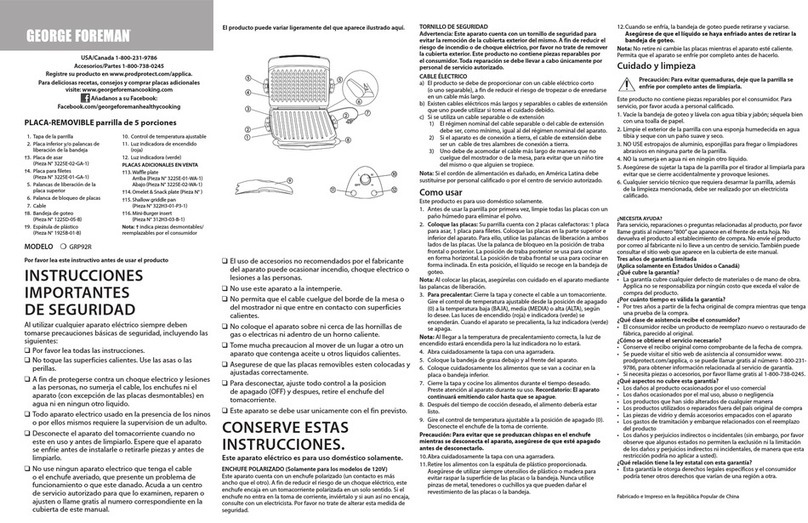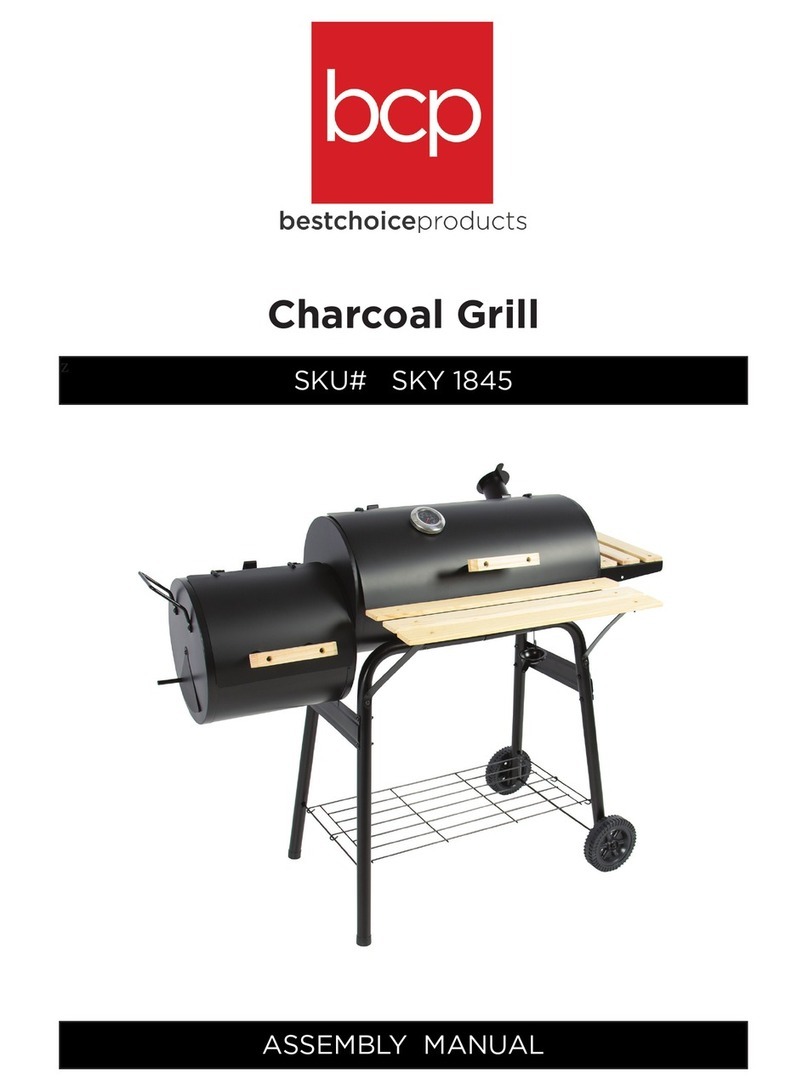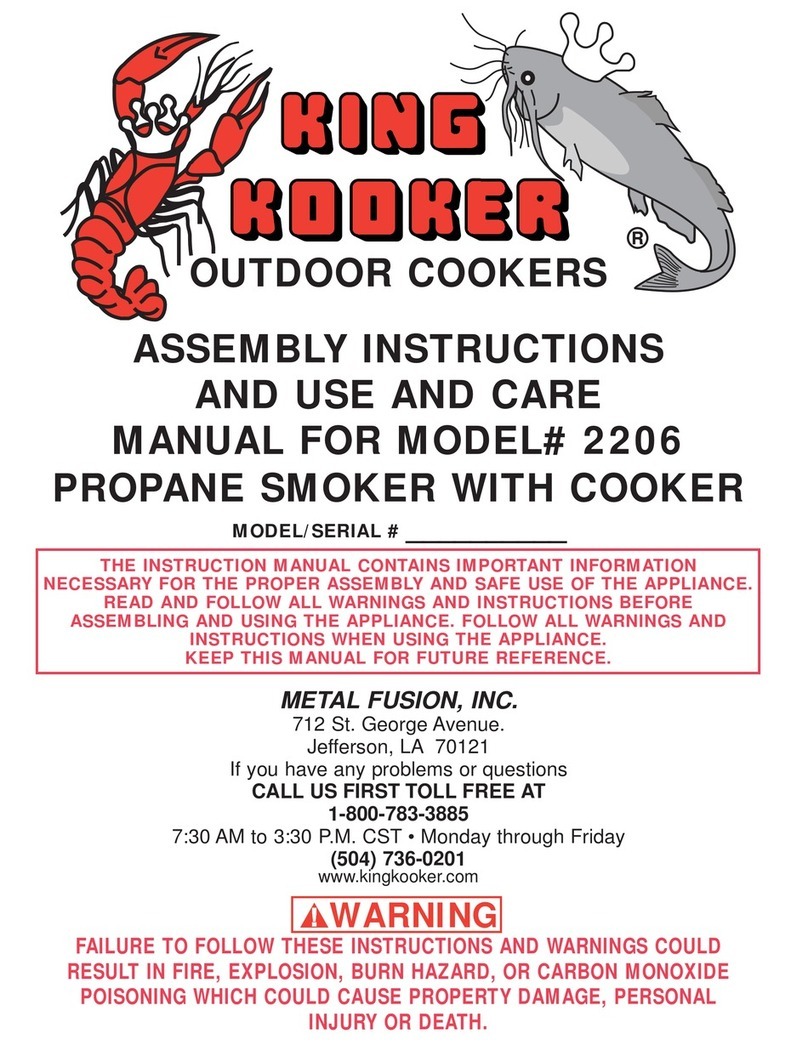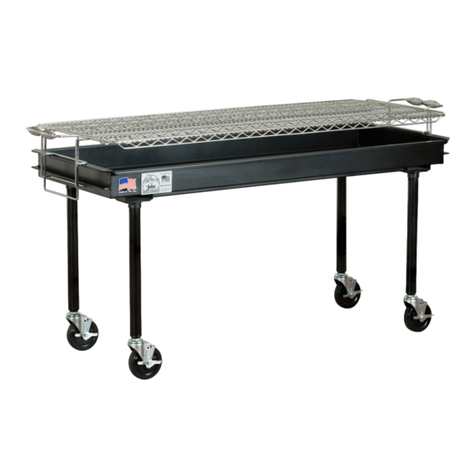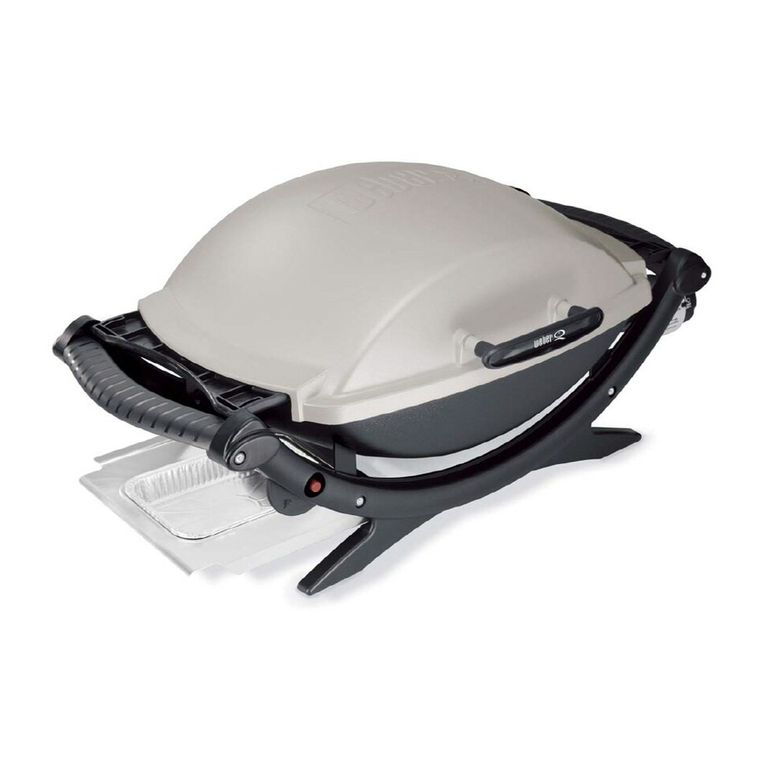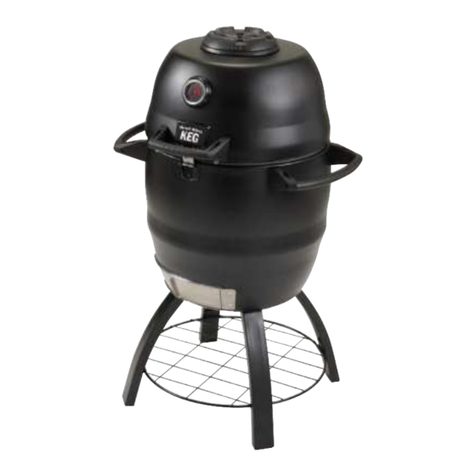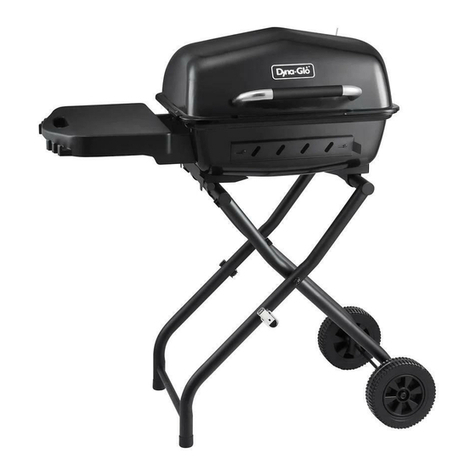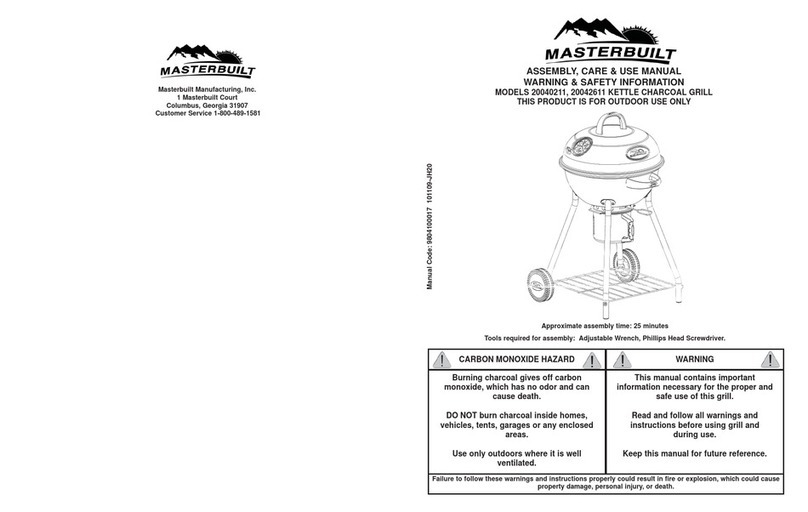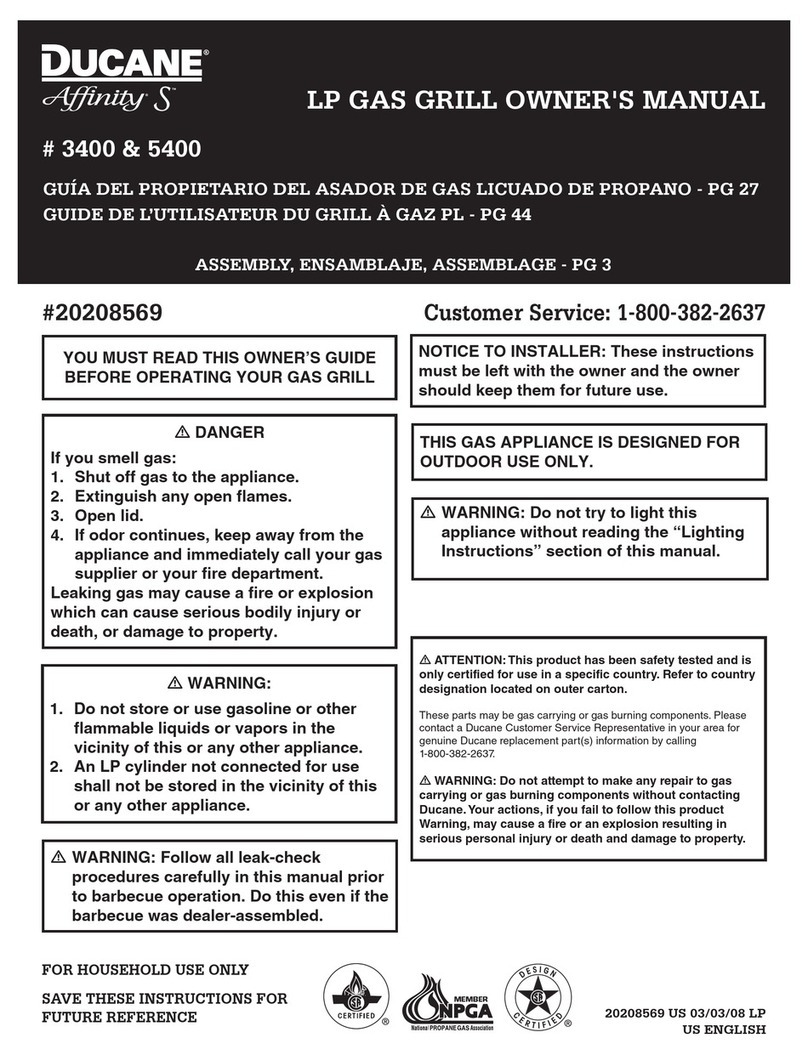Grillvapor GV 455 User manual

GRILLVAPOR
RADIANT HEAT COOKING
GV 455 - GV 855 - GV 1255
GV 470 - GV870 - GV 1270
GV 407 – GV 807 – GV 1207 – GV 409 – GV 809 – GV 1209
GV 417 – GV 817 – GV 1217 – GV 419 – GV 819 – GV 1219
GV 407/R – GV 807/R – GV 1207/R – GV 409/R – GV 809/R – GV 1209/R
GV 417/R – GV 817/R – GV 1217/R – GV 419/R – GV 819/R – GV 1219/R
GAS GRILL
ENGLISH
Instruction booklet for installation use maintenance
INDEX
NOTES FOR THE INSTALLER
pag. 02
TECHNICAL CHARACTERISTICS - CONFORMITY TO EEC DIRECTIVES
pag. 03
TECHNICAL DATA FOR THE EQUIPMENT WITHOUT PRESSURE REGULATION
pag. 03
TECHNICAL DATA FOR THE EQUIPMENT WITH PRESSURE REGULATION
pag. 04
GENERAL WARNINGS - INSTALLATION
pag. 05
INSTALLATION OF THE APPLIANCE
pag. 06
SMOKE EXHAUST - GAS CONNECTION
pag. 07
OPERATION WITH SUPPLY GAS IDENTICAL TO THAT PRESET
pag. 08
ADJUSTMENT FOR OPERATION WITH OTHER TYPES OF GAS
pag. 09
ACCESS AND DISASSEMBLY OF THE PIECES
pag. 09
NOTES FOR THE USER
pag. 10
USE NOTES
pag. 10
MAINTENANCE
pag. 11
PATTERN OF ASSEMBLY AND ASSEMBLY OF REPLACEMENT PARTS/ SPARE PARTS
pag.12-13
FIXING OF FEET - INSTALLATION OF FORNITURE
pag.14
TECHINCAL FILES
pag.15-20

2
NOTES FOR THE INSTALLER
CHART 1
Models Dimensions Gas pipe Cooking Total Total Air for Type Integrated
WxDxH fitting area power consumption combustion pressure
cm G UNI-ISO n° kW kg/h m³/h regulation
7/1 R1
GV 455 42x55x31,5
½
1 6,9 0,540 14 A1 No
GV 855 80x55x31,5
½
2 13,8 1,080 28 A1 No
GV 1255 119,5x55x31,5
1/2
3 20,7 1,620 42 A1 No
GV 470 42x70x31,5
½
1 8,5 0,67 17 A1 No
GV 870 80x70x31,5
½
2 17 1,34 34 A1 No
GV 1270 119,5x70x31,5
1/2
3 25,5 2,01 51 A1 No
GV 407 42x70x44
¾
1 10,5 0,822 21 A1 No
GV 807 80x70x44
¾
2 21 1,643 42 A1 No
GV 1207 119,5x70x44
¾
3 31,5 2,464 63 A1 No
GV 417 42x70x85
¾
1 10,5 0,822 21 A1 No
GV 817 80x70x85
¾
2 21 1,643 42 A1 No
GV 1217 119,5x70x85
¾
3 31,5 2,464 63 A1 No
GV 409 42x90x44
¾
1 13 1,017 26 A1 No
GV 809 80x90x44
¾
2 26 2,034 52 A1 No
GV 1209 119,5x90x44
¾
3 39 3,052 78 A1 No
GV 419 42x90x85
¾
1 13 1,017 26 A1 No
GV 819 80x90x85
¾
2 26 2,034 52 A1 No
GV 1219 119,5x90x85
¾
3 39 3,052 78 A1 No
GV 407R 42x70x44
¾
1 10,5 0,822 21 A1 Yes
GV 807R 80x70x44
¾
2 21 1,643 42 A1 Yes
GV 1207R 119,5x70x44
¾
3 31,5 2,464 63 A1 Yes
GV 417R 42x70x85
¾
1 10,5 0,822 21 A1 Yes
GV 817R 80x70x85
¾
2 21 1,643 42 A1 Yes
GV 1217R 119,5x70x85
¾
3 31,5 2,464 63 A1 Yes
GV 409R 42x90x44
¾
1 13 1,017 26 A1 Yes
GV 809R 80x90x44
¾
2 26 2,034 52 A1 Yes
GV 1209R 119,5x90x44
¾
3 39 3,052 78 A1 Yes
GV 419R 42x90x85
¾
1 13 1,017 26 A1 Yes
GV 819R 80x90x85
¾
2 26 2,034 52 A1 Yes
GV 1219R 119,5x90x85
¾
3 39 3,052 78 A1 Yes

3
( 1 ) TECHNICAL CHARACTERISTICS
The nameplate is positioned on the front or inside the control panel, you gain access to it by unscrewing
and removing the control panel.
- II2H3+ category appliance ( version without pressure regulation )
- I2H category appliance ( version with pressure regulation )
- Inlet pressure: Butane/Propane (G30-G31) 30/37mbar
Natural gas *H* (G20) 20mbar
- Injector pressure ( just for equipments with natural gas pressure regulator ) = 11mbar
CONFORMITY TO EEC DIRECTIVES
The appliance are constructed in observance of the requests of the European Union directives:
- 2009/142/EC (Gas appliances).
( 2 )
TECHNICAL DATA FOR THE EQUIPMENT WITHOUT PRESSURE REGULATION
CHART 2
BURNER: series 550 (GV ...55) - ONE AREA -
NOMINAL INPUT kW 6,9 REDUCED INPUT kW 5
Main burner Pilot light By-pass “X “ = mm*
injectors Ø 1/100mm injectors n° Ø 1/100 Main burner
primary air
Liquid gas 130 24 115 All open
(G30-G31)
Natural gas 200 29.2 Adjustable 1,5
(G20)
BURNER: series 770 (GV ...70) - ONE AREA -
NOMINAL INPUT kW 8,5 REDUCED INPUT kW 4,5
Main burner Pilot light By-pass “X “ = mm*
injectors Ø 1/100mm injectors n° Ø 1/100 Main burner
primary air
Liquid gas 145 24 115 2,0
(G30-G31)
Natural gas 215 29.2 Adjustable 1,0
(G20)

4
BURNER: series 700/710 (GV ...7) - ONE AREA -
NOMINAL INPUT kW 10,5 REDUCED INPUT kW 8,5
Main burner Pilot light By-pass “X “ = mm*
injectors Ø 1/100mm injectors n° Ø 1/100 Main burner
primary air
Liquid gas 160 24 180 11
(G30-G31)
Natural gas 240 29.2 Adjustable 3,5
(G20)
BURNER: series 900/910 (GV ...9) - ONE AREA -
NOMINAL INPUT kW 13 REDUCED INPUT kW 9
Main burner Pilot light By-pass “X “ = mm*
injectors Ø 1/100mm injectors n° Ø 1/100 Main burner
primary air
Liquid gas 180 24 180 20
(G30-G31)
Natural gas 265 29.2 Adjustable 3,5
(G20)
( 3 )
TECHNICAL DATA FOR THE EQUIPMENT WITH PRESSURE REGULATION
CHART 2
BURNER: series 700/710 (GV ...7R) - ONE AREA -
NOMINAL INPUT kW 10,5 REDUCED INPUT kW 8,5
Main burner Pilot light By-pass “X “ = mm*
injectors Ø 1/100mm injectors n° Ø 1/100 Main burner
primary air
Natural gas 290 29.2 Adjustable 6
(G20)
BURNER: series 900/910 (GV ...9R) - ONE AREA -
NOMINAL INPUT kW 13 REDUCED INPUT kW 9
Main burner Pilot light By-pass “X “ = mm*
injectors Ø 1/100mm injectors n° Ø 1/100 Main burner
primary air
Natural gas 330 29.2 Adjustable All open
(G20)
* See air adjustment diagram at the back of the booklet, fig. 6.

5
( 4 ) GENERAL WARNINGS - INSTALLATION
Carefully read the warnings container in this booklet in that they provide important indications regarding
installation, use and maintenance safety. Keep this booklet for further consultation by the various
operators.
After having removed the packaging make sure that the appliance is complete. In case of doubt, do not use
the appliance and consult professionally qualified personnel.
Before connecting the appliance make sure that the data plate information corresponds to that of gas and
electrical distribution network.
The appliance must be used only by personnel trained in its use.
Before carrying out the cleaning and maintenance operations disconnect the appliance from the gas supply
network.
Deactivate the appliance in case of breakdown or poor functioning. For any repair consult only an
authorized technical assistance and request the use of original spare parts. Failure to observe the above
can compromise the safety of the appliance.
The installation of this appliance must be done by a competent person in accordance with the
relevant requirements of the Gas Safety Regulations, the local Building Regulations, the IEE
Regulations and the by-laws of the local Water Undertaking.
It should be in accordance with any relevant requirements of the local gas Region or LPG supplier
and the relevant recommendations of the British standards (latest edition) concerned.
The electrical safety of this appliance is insured only when it is correctly connected to an efficient
grounding system as provided for in the electrical safety standard in force. It is necessary to verify
this fundamental safety requirement aid if in doubt request a thorough check of the system by
professionally qualified personnel. The manufactured cannot be considered responsible for any
damage caused by failing to have the system grounded.
This appliance must be used only in the way in which it was expressly intended.
DO NOT wash the appliance with direct high pressure water jets.
DO NOT obstruct the suction or heat disposal openings or fissures.
In order to avoid oxidation risk or general chemical aggression keep the stainless surfaces very clean.
Clean the stainless steel parts daily with warm soapy water then rinse thoroughly and dry carefully.
Absolutely avoid cleaning the stainless steel with scouring pads, brushes or common steel scrapers in that
they can deposit ferrous particles that by oxidizing can provoke rust. Steel wool can be used in the
direction of the finish.
If the appliance is not used for a long period of time close the gas cock and wipe all the steel surfaces with
a cloth soaked in oil or vaseline in order to extend a protective film; also periodically air out the premises.
The manufactured of the appliance declines any responsibility for damage caused by incorrect installation,
tampering of the appliance, improper use, poor maintenance, non-observance of local standards and
unskilled use.
Before connecting check on technical plate that the appliance has been tested and homologated for the
type of gas available for the user.
If the type of gas indicated on the plate is not that which is available follow the indications of the paragraph
"Transformation to another type of gas".
WARNING: For the connection of the smoke exhaust see the "SMOKE EXHAUST" chapter.

6
( 5 ) INSTALLATION OF THE APPLIANCE
The gas systems and the installation site of the appliance must be in accordance with the regulations in the
various areas and in particular you must consider that the air for combustion in the burners is 2m
3
/h for
every kW of power installed and that the accident prevention standards must be observed.
The appliance must be installed with sufficient ventilation to stop the formation of inadmissible
concentration of substances harmful to your health.
(5-a) Laying of the appliance
Remove the packaging from the appliances and set them in the place of use seeing to their levelling and
height adjustment by means of adjustable feet and other means (fig. 1). Remove the protective film from
the external panels, detaching it slowly to stop the glue from remaining.
It is important that the walls adjacent to the appliance are protected against heat. Place refractory sheets or
place the appliances at least 200mm from the side or rear walls.
Insert the stack terminal (fig. 2) if it is supplied disassembled.

7
( 6 ) SMOKE EXHAUST
The appliance must be installed in rooms suitable for the exhaust of the products of combustion which
must occur in observance of that prescribed by the installation standards. Our appliances are considered
as type A gas appliances (see technical data charts).
Such appliances must discharge in special hoods or similar device, connected to a surely efficient duct
which discharges directly to the outside.
WARNING: The appliances, whose total heat input (see chart 1) is higher than 14kW, must obligatory be
installed under a forced extraction suction hood and discharge towards the outside.
In this case the system must act, in the case of lack of electrical energy or reduction in the suction capacity,
intercepting and directing the gas supply system to the appliance. In particular, it will have to close the
solenoid valve placed in the supply circuit upstream from the appliance.
The input limits are established by the installation standards in force.
For information purposes, the suction hood guarantee a suction capacity equal to a volume of 35m³/h of air
for every kW of heat input.
Conveyors which gather the barbecue smoke and that convey it towards a single point of exhaust can be
supplied upon request; in this case as well, the appliance must be always positioned under a suction hood.
( 7 ) GAS CONNECTION
The connection of the appliances must be always done with 3 piece pipe fittings in order to facility
disassembly.
It must be done by means of galvanized metallic or copper pipes, positioned will is sight. You must also
have a gas stop cock upstream from every appliance.
If the flexible pipes are used, they must be in stainless steel.
After having carried out the gas connection, check its seal using a frothy spray.

8
( 8 ) OPERATION WITH SUPPLY GAS IDENTICAL TO THAT PRESET
Check if the indication on the nameplate correspond to the gas distributed, check also the correspondence
of the following.
( 8-a ) Checking the inlet (Fig. 3)
THE APPLIANCES ARE NOT SUPPLIED WITH PRESSURE REGULATOR ( MODEL WITHOUT THE
ABBREVIATION …..R), ITS CATEGORY IS II2H3+ AND CAN BE ADAPTED TO OTHER TYPES OF GAS
(for example from natural gas to LPG and vice versa). SEE CHAPTER 9 FOR REGULATION AND
TRANSFORMATION.
THE APPLIANCES SUPPLIED WITH PRESSURE REGULATOR (MODELS WITH ABBREVIATION …..R )
HAS CATEGORY I2H, THEY WORK ONLY WITH NATURAL GAS AND CANNOT BE TRANSFORMED.
THE PRESSURE REGULATOR IS SEALES IN FACTORY AND IT MUST NOT BE CHANGED.
The inlet pressure can be measured by means of a gauge with a "U" shaped pipe or an electronic type with
a minimal subdivision of 0,1mbar.
APPLIANCES WITHOUT PRESSURE REGULATION (they work with natural gas or LPG)
- Unscrew screw "A" from the pipe tap "B" (fig.3).
-Position the pressure gauge
-Operate the appliance and check that the pressure is as chapter “
TECHNICAL CARACTERISTICS
”, in
case of the contrary find out the cause.
- At the end of the operation close the pipe tap again.
APPLIANCES WITH PRESSURE REGULATION (they work only with natural gas)
- Unscrew screw "A" from the pipe tap "B" (fig.3).
-Position the pressure gauge
-Operate the appliance and check that the pressure is as chapter “
TECHNICAL CARACTERISTICS
”, in
case of the contrary find out the cause.
- At the end of the operation close the pipe tap again.
The pressure regulator is sealed and it must not be changed. Follow the following instruction to check the
pressure of the injector:
- It can be use the pressure plug “B” (fig.3) or the exit pressure plug of the pressure regulator “B” (fig.8),
the one which is easier to reach.
- Unscrew screw "A" of the pressure plug "B".
-Position the pressure gauge.
-Start up the appliance and check the pressure following the chart 1.1.
- At the end of the operation close the pressure plug.
( 8-b ) Adjustment of the primary air (Fig. 6)
Check the primary air is adjusted according to the data stated in chart 2.
( 8-c ) Pilot flame adjustment
The pilot flame with fixed nozzles does not need any adjustment.
( 8-d ) Checking the main burner
Turn on the appliance and check that the flame, the ignition and the minimum adjustment, if existing, are
correct. If this does not happen, check the injectors (see chart 2).

9
( 9 ) ADJUSTMENT FOR OPERATE WITH OTHER TYPES OF GAS
BEFORE ADJUSTING CHECK THE GAS CATEGORY OF THE APPLIANCE.
If the appliance has category I2.. it will be supplied with pressure regulator. In this case NO CHANGES
ARE ALLOWED.
If the appliance has gas category II.. (it is not supplied with pressure regulator) it can be regulated for the
transformation from natural gas to LPG and vice versa. To do this follow the instructions:
change the injectors of the main burners and of the pilot flame, regulate the reduced range (see chart 2)
and regulate the primary air of the main burners.
All the injectors necessary for the adjustment are supplied in a bag together with the appliance.
The injectors of the burner are marked in hundredths of mm, while those of the pilot flame have a reference
number.
( 9-a ) Replacement of the injectors and regulations
To reach the main injectors remove the drawers and the plate under the drawer.
To reach the pilot, you must follow this procedure
• remove the terminal from the stack, detail (Fig. 2)
• remove the front from the stack, detail (Fig. 2)
• remove the hack
• extract the water collection drawer, detail (Fig. 4)
• extract the bottom plate, detail (Fig. 4)
• remove the knob and extract the piezoelectric device, detail. (Fig. 4)
• unscrew the self-threading screws of the front and detach it, detail (Fig. 4)
( 9-a1 ) Pilot flame (Fig. 5)
Replace the nozzle "G" according to that stated in chart 2 after having unscrewed nut "H".
The pilot flame does not need any adjustment.
( 9-a2 ) Main burner (Fig. 5 e 6)
Unscrew the injectors "E". Assemble the foreseen injector according to chart 2.
( 9-a3 ) Minimum adjustment (Fig. 7)
Remove the knob and adjust the flame in the minimum position until a stable and even flame is obtain; for
the suitable input see chart 2.
For the operation with liquid gas the adjustment screw indicated by an arrow (Fig. 07) must be screwed
down completely.
After each new adjustment of screw, seal itself with paint or sealing wax.
( 9-b ) Adjustment of the primary air of the burner (Fig. 6)
The air adjustment ferrule is to be positioned in the "X" mm measurement stated in chart 2. After the
positioning, screw down the blocking screw and check the appearance of the flame.
( 10 ) ACCESS AND DISASSEMBLY OF THE PIECES
(To be done only by qualified installers)
( 10-a ) Gas cock, pilot, ignition spark plug, thermocouple, burners
To gain access to these details you must remove several panels or particular plates as illustrated in figure
4 and in paragraph 9-a.
Once the components have been made accessible their replacement is very easy, unscrewing their own
nuts or attachments for each one.
After each replacement repeat the seal test of the gas circuit.

10
NOTES FOR THE USER
(12) USE NOTES
The appliance must be used by qualified personnel, being an appliance exclusively for professional
kitchens. The installation operations, any transformations for use with other types of gas, the setting at
work, the elimination of any inconvenient to the system, must be done only by qualified personnel in
accordance with the standards in force.
Correctly position the cooking grills and any overlaying plate before turning on the appliance.
The grills and the plates are burning hot during use: remove them only when the appliance is off.
IMPORTANT WARNINGS
To avoid overheating, unless smoke and the danger of the oil in the collection trays catching fire, cooikng
is always done with the tray under the burners, full of water, keeping an eye on the level during the
cooking.
Several models are supplied with a water supply system.
Before beginning cooking check that the trays are full of water, in case of the contrary fill them.
In order to do this:
1) Open the drawer-tray and extract the dividing tray (for the models with two or more areas)
2) with a jug, fill up to one or two centimeters from the edge. During the use of the appliance check the
level.
In the models with built-in cock, for the tray water supply and with the overflow device, it is enough to open
the cock until reaching the overflow level and close the cock itself almost completely, leaving only a small
stream to keep the level.
( 12-a ) Ignition and turning off
( 12-a1 ) Main burner
Before turning on the burner, identify the correct command knob; each knob commands the respective
underlaying cooking area.
( 12-a2 ) Ignition of the pilot flame
Press the black knob and turn it towards left on the
position
Keeping the knob pressed, press the piezoelectric push-bottom. After having turned on the pilot flame keep
the knob pressed to the end for a few more seconds in order to allow the thermocouple to heat. Release
the knob. If the pilot flame extinguishes repeat the operation. The pilot flame can be observed through the
opening between the work plane and the control panel.
( 13-a3 ) Ignition of the main burner
To turn on the main burner turn the knob towards the left on the "maximum" position (large flame), or
directly on the "minimum" position (small flame). Between these two position it is possible to select the
desired caloric input for cooking.
( 13-a4 ) Spegnimento
To turn off the main burner, turn the knob towards the right on the
position, in this way only the pilot
flame will remain on. By continuing to turn the knob up to the
position the pilot flame will also turn off.

11
7. MAINTENANCE
It is recommended to draw up a contract for maintenance at least once a year.
If the rotation of the knob stiffens, it is also recommended to have the cocks directly replaced by the
technical assistance.
The cleaning of the stainless steel part must be done delicately using warm water. If you use soap or
detergent make sure that these do not contain abrasive products and that they are recommended for
cleaning stainless steel.
If the appliance is not used for a certain period of time, close the gas supply cock.
If the appliance should break down or have irregular functioning it is necessary to close the main gas
arrival cock and call the technical service.
All the reparation and breakdown adjustment operations must be done by competent installers.

12
FIG. 01 Fig. 02
FIG. 03 FIG. 04
FIG. 05

13
FIG. 06 FIG. 07
FIG. 08 FIG. 09
FIG. 10 FIG. 11

14
FIXING OF FEET ON FORNITURE
1) Position the platens in
corrispondence to the proper
holes.
2) Fix the platens at the
bottom o the piece of
equipment.
3) Screwin the pivot.M10
which is in the middle of the
platens.
INSTALLATION OF FORNITURE
1) Lay down the Grillvapor
on forniture and fix
the 4 screws.

15

16

17

18

19

20
This manual suits for next models
28
Table of contents



